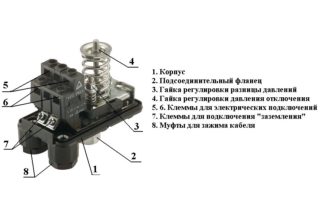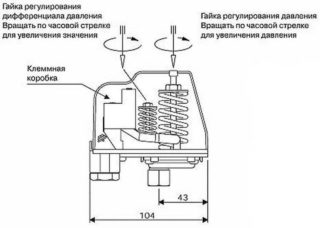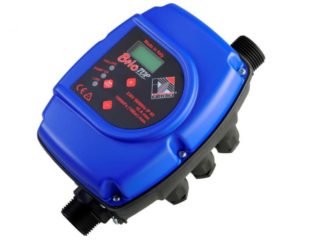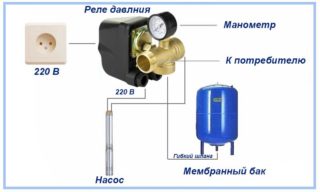The operation of an autonomous water supply system is based on the efficient and economical operation of pumping equipment, which creates the required water pressure within the network. In addition to the pump and pipework, another device is installed that is responsible for turning on and off pumping units - a water pressure switch in the water supply system for a private house.
Types and principle of operation of the relay

The main type of pressure sensors is electromechanical. It contains several contacts that are responsible for the automatic start of the pump and a mechanical regulator of the water pressure level, to which the electrical part of the device will respond. The adjustment is done manually.
The principle of operation of the device is based on plate bending. She, in turn, closes one of the two contacts. One of them turns on the pump, the other turns off. The bending of the plate is limited by two springs, which are manually adjusted.
One of the springs reacts to high water pressure inside the water supply network, the other to the minimum set. As soon as the water pressure in the water supply pipe falls, the plate straightens, short-circuiting the contact to start the pump motor. The pressure increases, the spring begins to press on the plate, which bends. Its pressure on the "start" contact weakens and, in a certain state, ceases to act. But at the same time, pressure occurs on the second contact, which is responsible for stopping the pumping unit.
Relay adjustment and setting

The adjustment of the water movement sensor in the pipe is made with nuts that support the springs. By increasing the compression ratio of the springs, they achieve automatic operation of the pressure switch, depending on the pressure of the liquid inside the water supply system. The more the nuts are tightened, the more pressure the device will react to and vice versa.
Water pressure sensors, which are used in autonomous networks in suburban areas, are small-sized devices that come on sale with ready-made standard settings. They will respond to a minimum pressure of 1.5 atm. And a maximum pressure of 3 atm. If, for some reason, it is required to adjust the sensor for the presence of water in the pipe, it is necessary to remove the cover of the device, which is attached to the body with a screw. Then tighten or loosen the spring nuts with a wrench. In place of the nuts on the body, risks are made that determine the degree of loosening or compression.
The relay has two springs, which differ in size from each other. One has a large diameter, the other has a small one. By twisting the first one, you can solve the problem of pressure level control - increase the nominal pressure or decrease it. Twisting the second one solves the problem of the superiority of high pressure over low pressure - it is possible to increase or decrease the difference between the maximum and minimum parameters.
If the pressure difference is large, and the on / off relay is installed on the accumulator, you can save on frequent switching on / off of the pumping unit. The difference must not be allowed to be less than 1 atm. It is impossible to adjust the device without taking into account the maximum pressure that the pump delivers - it is strictly forbidden to adjust more than the set value.
Electronic sensors

This type of relay differs from an electromechanical relay in that it cannot be manually adjusted.Devices come on sale with ready-made settings. Therefore, it is very important to choose the right device for the following parameters of the water supply network:
- power and head of the pumping unit, special attention to the limiting pressure indicator;
- the throughput (performance) of the water supply system, which depends on the number of consumers.
The household relay is regulated for a minimum pressure in the range of 1.5-1.8 atm., A maximum pressure of 2.5 to 3 atm. Electronic devices are usually installed on hydraulic accumulators. Electromechanical can be installed anywhere in the plumbing system. The main thing is a small distance from the pump so as not to pull the electrical wiring far.
The first start-up of a water supply system with a built-in electronic relay can be puzzling, because the device does not turn on immediately, but after 15-20 seconds. During this time, the sensor is automatically adjusted.
The setting of the electronic pressure switch can also be carried out manually, if the necessary situation has arisen. This is done using the buttons located on the front of the device. There is also a display on which numbers are displayed showing the nominal pressure value.
Connection diagram and rules

It is necessary to connect a pressure switch for a water supply system with a submersible pump or any other strictly according to the instructions offered by the manufacturer. The device is connected to the water supply using a fitting, at the end of which an external thread is made. To do this, a tee is screwed into the selected point, a cut of a part of the pipe is preliminarily made. The sensor is screwed into the free hole of the fitting. Be sure to seal the joint using an FUM tape.
There is an option when the connection is not made directly - the relay is installed outside the water pipe, and the connection is made with a flexible hose. This makes it possible to mount the device in a place convenient for maintenance.
Installation in a tee does not make it possible to twist the device about its axis after its installation, because the final fastening is tightening the lock nut. The latter will firmly fix the sensor in place. Therefore, it is necessary to accurately calculate the number of turns in order to achieve the correct positioning of the relay with maximum tightness of the connection point.
The next step is to connect the pressure sensor to the pumping unit. To do this, you need to select an electric cable with a cross section that must correspond to the power of the pump electric motor. For example, if the motor power exceeds 2.2 kW, the minimum cable section is 2.5 mm².
To connect to the terminal box of the device, you must first remove the cover. Contacts are usually indicated by symbols or numbers. The instructions indicate exactly which contact to which terminal of the electric motor should be connected. It is important not to be mistaken here. There is a diagram in the instructions.
If there is a grounding terminal in the terminal box, indicated by the inscription "ground" or some other sign, you will have to ground the device.
Experts recommend installing one pressure gauge next to the sensor. With it, you can monitor the water pressure inside the water supply.
The water pressure switch is a universal device. It not only monitors the operation of a pump installed in an autonomous water supply system, but also turns it off in non-standard extreme situations, for example, when a well or a well runs out of water.








